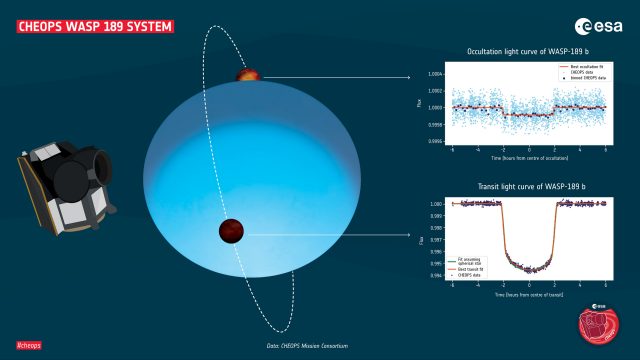CHEOPS keeps its promise: Observations with the space telescope have revealed details of the exoplanet WASP-189b—one of the most extreme planets known. CHEOPS is a joint mission by the European Space Agency (ESA) and Switzerland, under the aegis of the University of Bern in collaboration with the University of Geneva.
Eight months after the space telescope CHEOPS started its mission, the first scientific publication using data from CHEOPS has been issued. CHEOPS is the first ESA mission dedicated to characterizing known exoplanets, those orbiting stars outside the solar system. Exoplanets were first found in 1995 by two Swiss astronomers, Michel Mayor and Didier Queloz, who were last year awarded the Nobel Prize for this discovery. CHEOPS was developed as part of a partnership between ESA and Switzerland. Under the leadership of the University of Bern and ESA, a consortium of more than 100 scientists and engineers from 11 European states was involved in constructing the satellite over five years. The Science Operations Center of CHEOPS is located at the observatory of the University of Geneva.
Using data from CHEOPS, scientists have recently carried out a detailed study of the exoplanet WASP-189b. The results have just been accepted for publication in the journal Astronomy & Astrophysics. Willy Benz, professor of astrophysics at the University of Bern and head of the CHEOPS consortium, said, “These observations demonstrate that CHEOPS fully meets the high expectations regarding its performance.”
One of the most extreme planets in the universe
WASP-189b, the target of the CHEOPS observations, is an exoplanet orbiting the star HD 133112, one of the hottest stars known to have a planetary system. “The WASP-189 system is 322 light years away and located in the constellation Libra (the weighing scales),” explains Monika Lendl, lead author of the study from the University of Geneva, and member of the National Center of Competence in Research PlanetS.
Find your dream job in the space industry. Check our Space Job Board »
“WASP-189b is especially interesting because it is a gas giant that orbits very close to its host star. It takes less than three days for it to circle its star, and it is 20 times closer to the star than Earth is to the Sun,” Monika Lendl says. The planet is more than 1.5 times as large as Jupiter, the largest planet of the solar system.
Monika Lendl further explains that planetary objects like WASP-189b are very exotic: “They have a permanent day side, which is always exposed to the light of the star, and, accordingly, a permanent night side.” This means that its climate is completely different from that of the gas giants Jupiter and Saturn in our solar system. “Based on the observations using CHEOPS, we estimate the temperature of WASP-189b to be 3,200 degrees Celsius. Planets like WASP-189b are called “ultra-hot Jupiters. Iron melts at such a high temperature, and even becomes gaseous. This object is one of the most extreme planets we know so far,” says Lendl.
Highly precise brightness measurements
“We cannot see the planet itself as it is too far away and too close to its host star, so we have to rely on indirect methods,” explains Lendl. For this, CHEOPS uses highly precise brightness measurements: When a planet passes in front of its star as seen from Earth, the star seems fainter for a short time. This phenomenon is called a transit. Monika Lendl says: “Because the exoplanet WASP-189b is so close to its star, its dayside is so bright that we can even measure the ‘missing’ light when the planet passes behind its star; this is called an occultation. We have observed several such occultations of WASP-189b with CHEOPS. It appears that the planet does not reflect a lot of starlight. Instead, most of the starlight gets absorbed by the planet, heating it up and making it shine.”
The researchers believe that the planet is not very reflective because there are no clouds present on its dayside. “This is not surprising, as theoretical models tell us that clouds cannot form at such high temperatures,” says Lendl.
Willy Benz says, “We also found that the transit of the gas giant in front of its star is asymmetrical. This happens when the star possesses brighter and darker zones on its surface. Thanks to CHEOPS data, we can conclude that the star itself rotates so quickly that its shape is no longer spherical, but ellipsoidal. The star is being pulled outward at its equator.”
The star around which WASP-189b orbits is very different from the sun. Monika Lendl says, “The star is considerably larger and more than 2000 degrees Celsius hotter than our sun. Because it is so hot, the star appears blue and not yellow-white like the sun.”
Willy Benz says, “Only a handful of planets are known to orbit such hot stars, and this system is the brightest by far.” As a consequence, it forms a benchmark for further studies. “We are expecting further spectacular findings on exoplanets thanks to observations with CHEOPS. The next papers are already in preparation.”
Provided by: University of Bern
More information: M. Lendl et al. The hot dayside and asymmetric transit of WASP-189 b seen by CHEOPS. Astronomy & Astrophysics (2020). DOI: 10.1051/0004-6361/202038677
Image: When a planet passes in front of its star as seen from Earth, the star seems fainter for a short time. This phenomenon is called a transit. When the planet passes behind the star, the light emitted and/or reflected by the planet is obscured by the star for a short time. This phenomenon is called occultation.
Credit: © ESA











